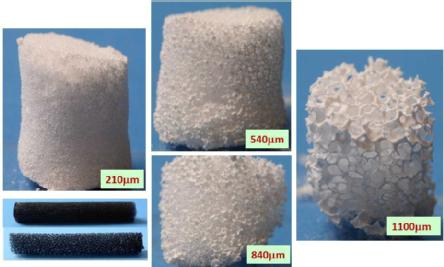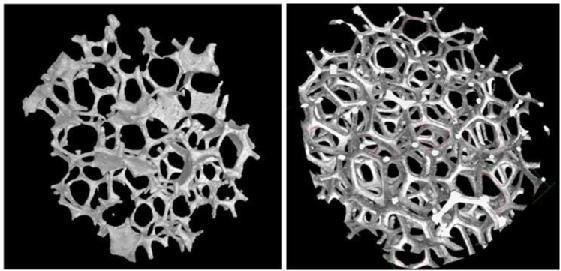My Research
Research into regenerative medicine, with a particular emphasis on bone, is an important field. Bone is able to self heal small defects, however for larger problems, some assistance is required. This can be achieved through grafting procedures, which are associated with many problems including lack of available material, donor site morbidity and the risk of infection, or scaffolding procedures. 3-dimensionally interconnected scaffolds allow for the ingrowth of bone over smaller areas and hence facilitate restoration of bone-like structures, or in the case of resorbable structures, fully healed defects.
Bone has a hierarchicaly structured porous network that has not been replicated by synthetic methods. There are many methods that allow for either macroporous or microporous structures, with both ideally required to facilitate the maximum potential for regrowth. The level and size of porosity, and the generation of multi-level porous structures is therefore immensely important, Methods currently used can be classed as either conventional of rapid prototyping, and each has its own advantages and limitations.

Another important part of the work involves the characterisation of the structures to ensure that they meet the desired requirements.
X-ray diffraction is used to determine whether any chemical or crystallographic changes have been made to the material during manufacture. For metals, this will inform us of any oxidation that may have occurred, purposefully or not; for ceramics, and in particular with calcium phosphates, it will tell us whether there have been any phase transformations. Calcium phosphates form a family of materials similar to the mineral phase of bone, however different ratios of calcium:phosphate affect, amongst other properties, the resorption time. This is particularly important when determining the optimal sintering temperature as lower ratios lead to increased resorption and regrowth is therefore required at a faster rate.

Research undertaken whilst I was an undergraduate into developing a technique, dubbed the adaptive foam reticulation (AFR), has proved to be a suitable method of developing structures with a hierarchical porous structure and has since been published. This involves the combination of two conventional techniques, synergising the advantages of both to generate scaffolds that enhance the biological response of cells when placed into simulated body fluid solutions. This method was developed using hydroxyapatite, a calcium phosphate which is chemically and crystallographically most similar to the mineral phase of bone and which resorbs over time with the formation of new bone. The scaffolds were tested in -vitro and the results were encouraging, with an enhanced response of osteoblast like cells. The use of Bioglass® has also been experimented with and has yielded similarly exciting results.
Main Supervisor:
Dr Greg Gibbons
Tel: +44 (0)24 765 22524
E-mail: G dot J dot Gibbons at warwick dot ac dot uk
Co-supervisor:
Professor Mark Smith
Tel: +44 (0)1524 592001
E-mail: m dot needham at lancaster dot ac dot uk
